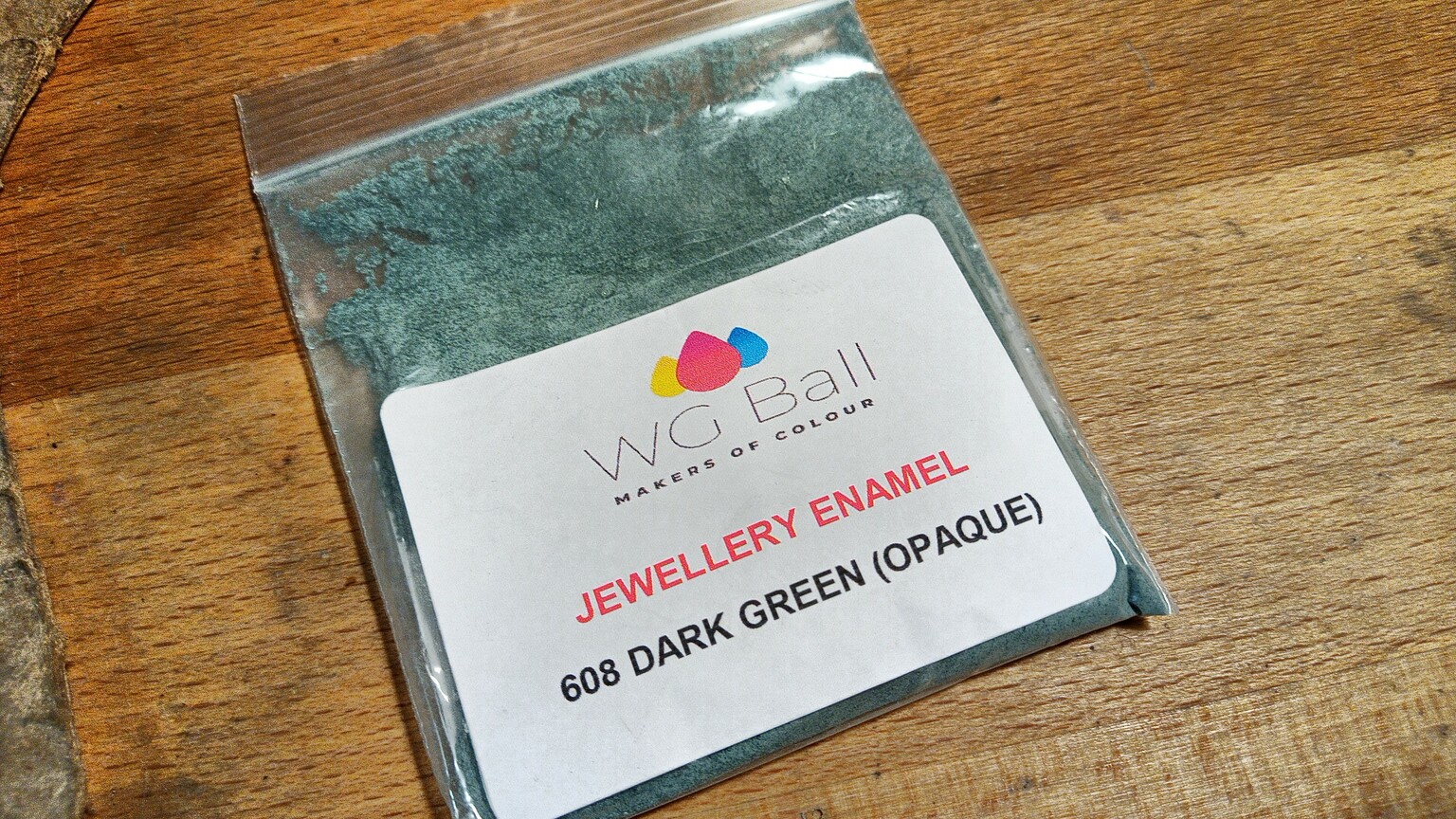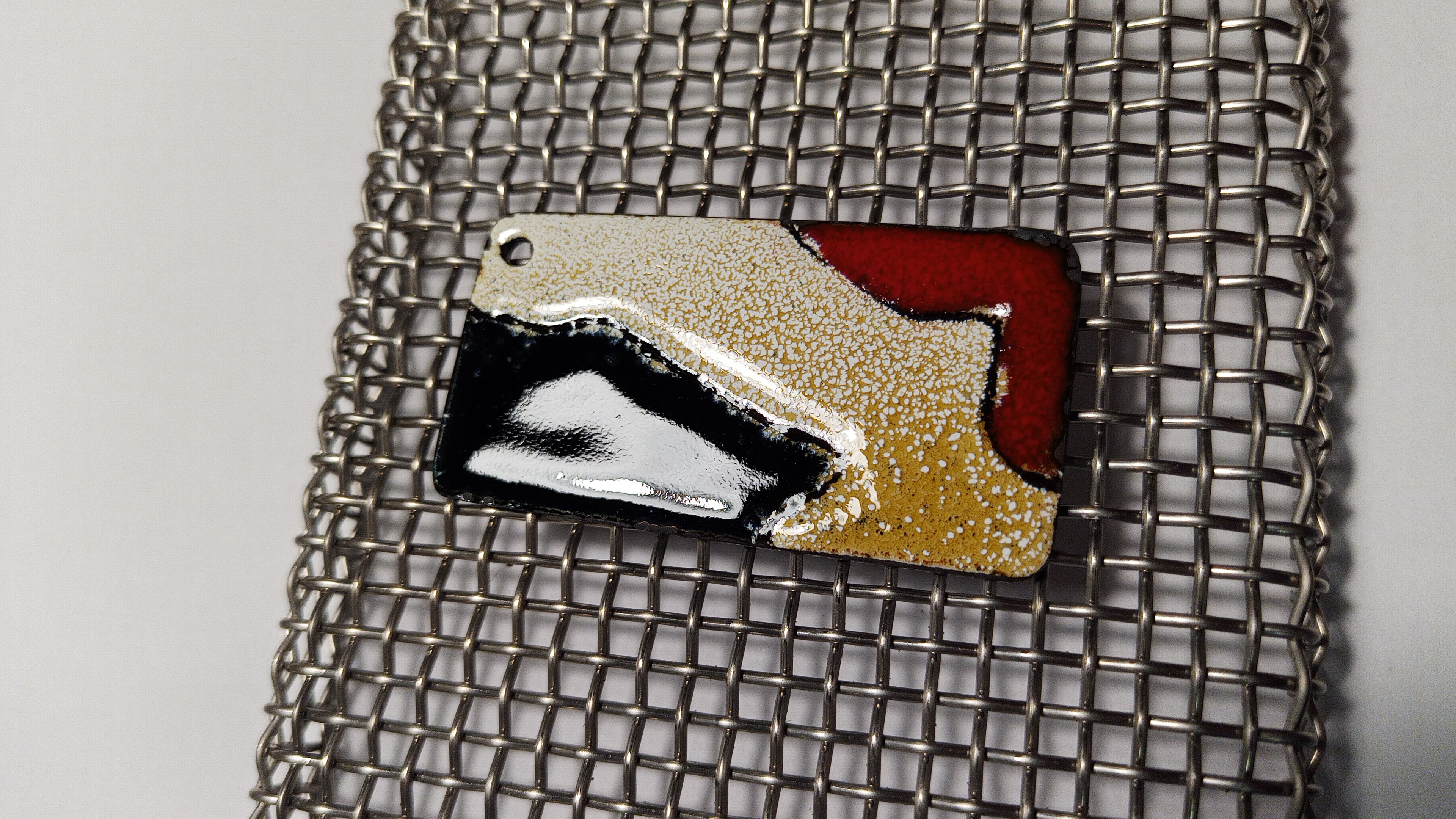If there’s one technique that’s poorly documented (in french) and fairly discreet on the web, it’s metal enamelling. I’ve only recently got started, after digging up all the sources I could find online: videos, blogs, various articles. Many of the resources are in English.
What exactly are we talking about?
Enamel
Wikipedia tells us:
Vitreous enamel, also called porcelain enamel, is a material made by fusing powdered glass to a substrate by firing, usually between 750 and 850 °C (1,380 and 1,560 °F). The powder melts, flows, and then hardens to a smooth, durable vitreous coating. The word vitreous comes from the Latin vitreus, meaning “glassy”.
Enamels of different colours are made by varying the metal oxides used. The melting point of an enamel varies according to its intended use. For use on metals, it is fairly low, at around 750 to 900°C, to take account of the melting point of the metals themselves (copper, gold, silver, steel).
Enamel must have a coefficient of expansion close to that of its substrate, otherwise it may crack or show defects. Unfortunately, this is a frequent problem, especially when we go beyond standard practice (copper, silver and gold all meet these criteria).
Enamel is usually a powder of varying grain size, which is used dry, mixed with water, or crushed and mixed with oil to form a paint.
There are opaque and transparent enamels. Transparent colourless enamel is sometimes referred to as ‘fondant’.
Safety point: enamel is toxic, even when it does not contain lead (which is preferable). You should protect your eyes, not inhale it or use it as a day cream.
What applications?
Metal is enamelled in various fields:
- jewellery
- manufacture of decorative objects and crockery
- furniture (enamelled tables)
- interior decoration (enamelled panels, coverings)
- signage (street signs, signs)
- artistic and plastic creation in the broadest sense, because enamel is a technique that encourages experimentation
It’s a rather rare practice a priori, but knife handles can also be enamelled! It was with this rather unusual objective in mind that I decided to carry out my first tests.
Note that enamelling large metal surfaces requires industrial tools, or at least more substantial ones. Marie-Hélène Soyer excels in this field, and you can admire some of her work on her website.
An enamelled plaque of public interest (Marianne Casamance, CC BY-SA 3.0)
Where can I buy enamel for metal?
If you are in France:
- Cookson Clal sells enamels from the English manufacturer WG Ball (25 gram packs only, €5 to €10 depending on colour).
- you can buy ‘Soyer’ enamels from the manufacturer (150g or 1kg packs) or from Ceradel. Check the delivery charges. With Emaux Soyer at least, they are not insignificant.
Alternatively, from Europe and UK, you can :
- buy enamels and materials from the American manufacturer Thompson through a Danish importer.
- buy WGBall enamels from a Cookson local website.

One sachet of WG Ball enamel powder
What are the main difficulties?
I would like to make it clear beforehand that this information is just advice I’ve seen elsewhere and tried out myself… It’s nothing to do with a treatise on enamelling. There may be errors or inaccuracies: don’t hesitate to point them out to me.
Metal deformation
When enamelling metals that are fairly soft and thin (copper jewellery, for example), it is essential to counter-enamel to prevent the surface from deforming.
Emilie Thibault explains it very well: http://www.les-instants-essentiels.fr/contre-emailler-cest-facile/ (in french).
Moisture
It’s simple: don’t put a piece in the kiln if there’s still water in the glaze or on the base. At 800°C, water boils very quickly, bubbles up and ruins everything in its path.
Believe me, it’s worth waiting until everything is completely dry.
Fat
As with any operation involving metal and heat, any residual grease will burn and oxidise, giving a mediocre result. When the metal is bare, you can make up for it, but for enamel, it’s more serious: it clings poorly (or not at all) to the metal, and everything has to be redone…
Conclusion: degrease the surface thoroughly before applying the enamel - with salt-saturated acetic acid, for example - and never put your fingers on it again.
The different techniques
Enamelling can be done using a variety of techniques: champlevé, cloisonne, grisaille, plique-à-jour, etc. I carry out my own tests but I don’t have enough experience to talk seriously about it at the moment. But I will!
Where can I find out more?
This section will be added to as we go along, but here are a few links.
In French:
- Les Instants Essentiels, already mentioned, a blog that isn’t updated but is full of useful and funny information.
- for jewellery, check out the ‘Email’ section of the ‘Bijoux à la cheville’ forum and its discussions between enthusiasts.
- a tutorial from Swiss supplier Hiller.
- a Wikipedia article on Metal enamellers’ know-how, which may give you a few pointers.
- some tutorial videos in French on Youtube (this one for example).
In English:
- lots of interesting info and videos on the website of the Californian art school ‘The Crucible’.
- many videos on Youtube, with the key words ‘enamel technique’ (for example).
There’s a lot of information out there, but it’s often superficial or partial (in french, at least). So you learn by making mistakes, by testing yourself, by putting together data gleaned here and there. Or by taking a course!
Good luck!
